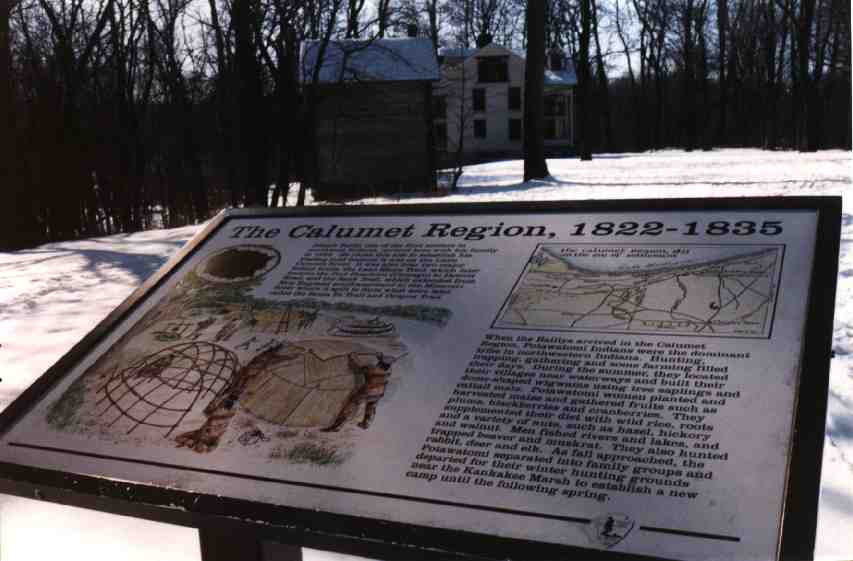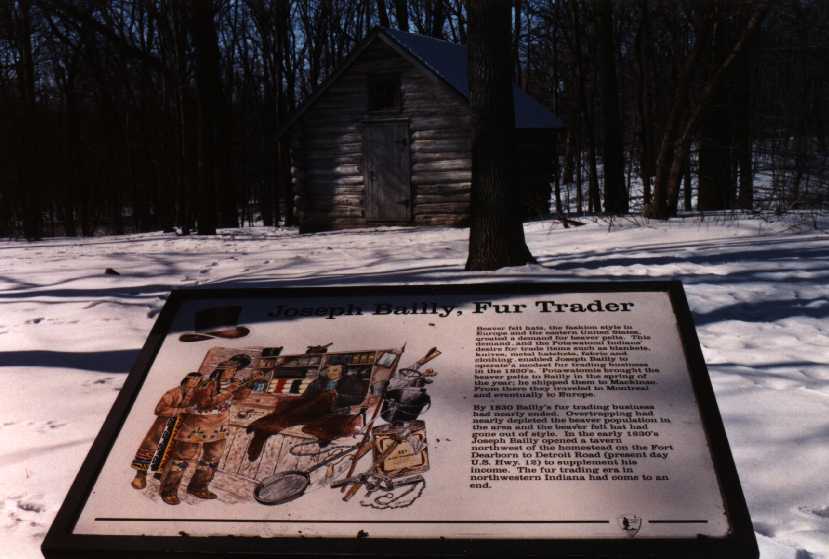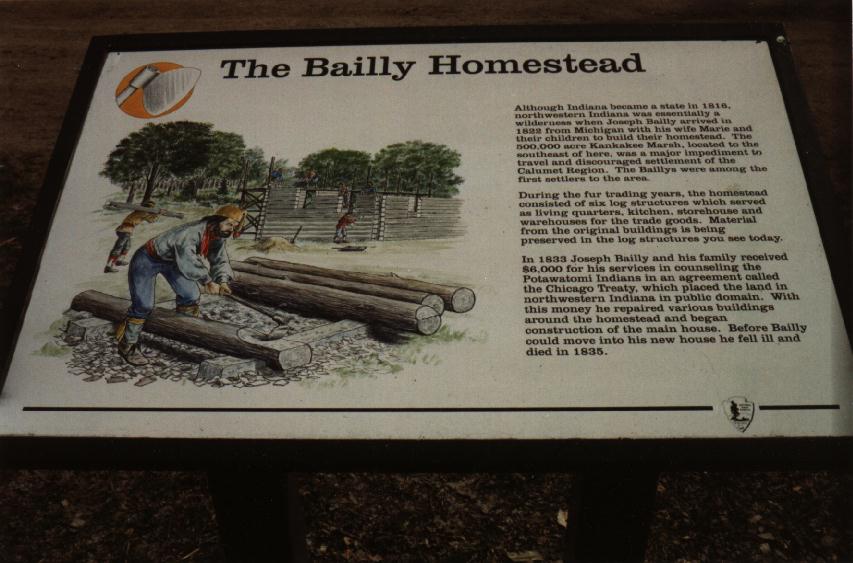

historical markers

markers page


|
| The Calumet Region, 1822-1835 | Highways of the Past | Joseph Bailly, Fur Trader | The Bailly Homestead |
|---|---|---|---|
| Joseph Bailly, one of the first settlers in northwest Indiana, arrived here with his family in 1822. He chose this site to establish his trading post because it was on the Little Calumet River. It was also near two major Indian trails, the Lake Shore Trail, which later became the Fort Dearborn (Chicago) to Detroit Road, and the Sauk Trail, which extended from New England southwestward to the Missouri River where it split to form what were later called the Santa Fe Trail and Oregon Trail. When the Baillys arrived in the Calumet Region, Potawatomi Indians were the dominant tribe in northwestern Indiana. Hunting, trapping, gathering and some farming filled their days. During the summer, they located their villages near waterways and built their dome-shaped wigwams using tree saplings and cattail mats. Potawatomi women planted and harvested maize and gathered fruits such as plums, blackberries and cranberries. They supplemented their diet with wild rice, roots and a variety of nuts, such as hazel, hickory and walnut. Men fished rivers and lakes, and trapped beaver and muskrat. They also hunted rabbit, deer and elk. As fall approached, the Potawatomi separated into family groups and departed for their winter hunting grounds near the Kankakee Marsh to establish a new camp until the following spring. |
Change is the best word to describe the Bailly Homestead since 1822. In the 1820's when the Potawatomi Indians brought their beaver pelts by canoe to trade with Joseph Bailly, the main house was yet to be built. Made of white oak logs with weatherboard siding, it was under construction in 1835 when Joseph Bailly died. The structure was completed after his death and has been altered on a number of occasions by the Bailly heirs. The exterior of the house has been restored to look as it did in 1917, the earliest year for which an accurate appearance could be documented. The brick house, built for Bailly's granddaughter, Rose Howe, was constructed in the late 1870's. As you walk these grounds, imagine the scenes, the people and changes that have occurred here. Picture Joseph Bailly greeting the Indians as they delivered their beaver pelts to trade. Hear the sound of the Indian and Bailly children playing while their parents bartered for trade goods. These people and the lives they led played a significant role in the history and development of the Calumet Region. |
Beaver felt hats, the fashion style in Europe and the eastern United States, created a demand for beaver pelts. This demand, and the Potawatomi Indians' desire for trade items such as blankets, knives, metal hatchets, fabric and clothing, enabled Joseph Bailly to operate a modest fur trading business in the 1820's. Potawatomis brought the beaver pelts to Bailly in the spring of the year; he shipped them to Mackinac. From there they traveled to Montreal and eventually to Europe. By 1830 Bailly's fur trading business had nearly ended. Overtrapping had nearly depleted the beaver population in the area and the beaver felt hat had gone out of style. In the early 1830's Joseph Bailly opened a tavern northwest of the homestead on the Fort Dearborn to Detroit Road (present day U.S. Hwy. 12) to supplement his income. The fur trading era in northwestern Indiana had come to an end. |
Although Indiana became a state in 1816, northwestern Indiana was essentially a wilderness when Joseph Bailly arrived in 1822 from Michigan with his wife Marie and their children to build their homestead. The 500,000 acre Kankakee Marsh, located to the southeast of here, was a major impediment to travel and discouraged settlement of the Calumet Region. The Baillys were among the first settlers to the area. During the fur trading years, the homestead consisted of six log structures which served as living quarters, kitchen, storehouse and warehouses for the trade goods. Material from the original buildings is being preserved in the log structures you see today. In 1833 Joseph Bailly and his family received $6,000 for his services in counseling the Potawatomi Indians in an agreement called the Chicago Treaty, which placed the land in northwestern Indiana in public domain. With this money he repaired various buildings around the homestead and began construction of the main house. Before Bailly could move into his new house he fell ill and died in 1835. |




 |
Indiana historical markers |
main historical markers page |
 |
 |
|
|---|
Have you found this page useful or interesing? If so, please join the free Historians Club. We wish to have lots & lots of members so that we can have more features.
Questions, complaints, suggestions, additional links? Please e-mail the webmaster.
This page is at https://ianhistor.tripod.com/hlmkr/baillyho.html.
This page developed 4th February, 2000.